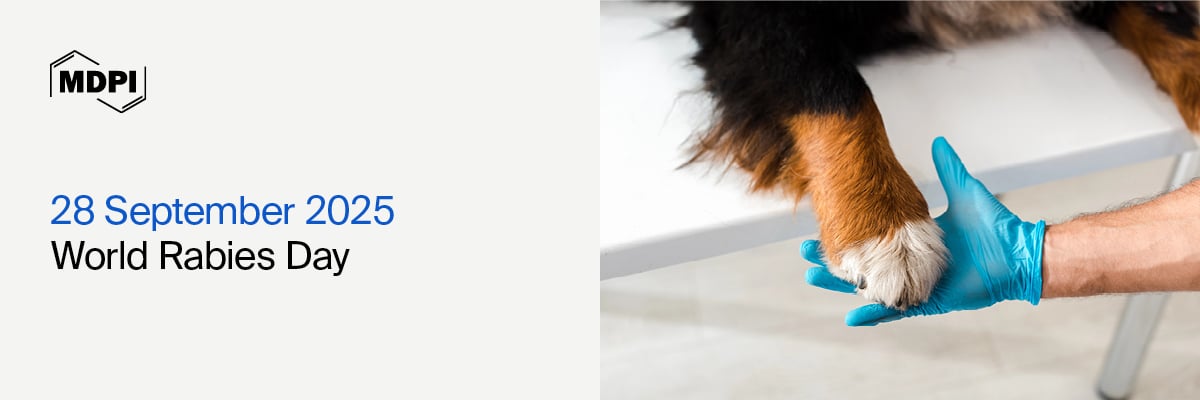
World Rabies Day—“Act Now: You, Me, Community”, 28 September 2025
World Rabies Day, celebrated annually on 28 September, aims to raise awareness of rabies prevention and highlight the progress made in defeating this dreaded disease. Rabies is a zoonotic disease caused by a virus, primarily transmitted through bites or scratches from animals such as dogs and cats. The virus attacks the central nervous system, resulting in a near-100% mortality rate and posing a serious threat to human health.
MDPI’s Life & Biology Sciences subject encourages the use of open academic exchange platforms provided by journals. Through scientific communication and experimental exchange, we aim to enhance understanding of the entire rabies prevention and control chain, promote innovative research, and build academic consensus and practical strength towards the global goal of ending deaths caused by rabies.




Keynote Speakers:
 |
|
|
|
Dr. Maria Cristina Schneider, |
Dr. Marco Vigilato, |
Dr. Nidia Aréchiga-Ceballos, |
Free to register here!

“Population Demographics of Owned Dogs in Greater Bangkok and Implications for Free-Roaming Dog Population Management”
by Elly Hiby, Tuntikorn Rungpatana, Alicja Izydorczyk, Valerie Benka and Craig Rooney
Animals 2025, 15(9), 1263; https://doi.org/10.3390/ani15091263
“The Deadly Details: How Clear and Complete Are Publicly Available Sources of Human Rabies Information?”
by Natalie Patane, Owen Eades, Jennifer Morris, Olivia Mac, Kirsten McCaffery and Sarah L. McGuinness
Trop. Med. Infect. Dis. 2025, 10(1), 16; https://doi.org/10.3390/tropicalmed10010016
“A Perspective of the Epidemiology of Rabies in South Africa, 1998–2019”
by Ayla J. Malan, Andre Coetzer, Cayla Bosch, Nicolette Wright and Louis H. Nel
Trop. Med. Infect. Dis. 2024, 9(6), 122; https://doi.org/10.3390/tropicalmed9060122
“Intrinsic Disorder in the Host Proteins Entrapped in Rabies Virus Particles”
by Hafiza Nimra Ashraf and Vladimir N. Uversky
Viruses 2024, 16(6), 916; https://doi.org/10.3390/v16060916
“Management Strategies for Common Animal Bites in Pediatrics: A Narrative Review on the Latest Progress”
by Dragos Septelici, Giulia Carbone, Alessandro Cipri and Susanna Esposito
Microorganisms 2024, 12(5), 924; https://doi.org/10.3390/microorganisms12050924
“The Effect of Sample Handling on Rabies-Neutralizing Antibody Stability”
by Samantha J. Pralle, Stephanie K. Gatrell, Cassidy C. Keating, and Susan M. Moore
Biologics 2024, 4(3), 232-241; https://doi.org/10.3390/biologics4030016
“Fifty Years of the National Rabies Control Program in Brazil under the One Health Perspective”
by Maria Cristina Schneider, Kyung-Duk Min, Phyllis Catharina Romijn, Nelio Batista De Morais, Lucia Montebello, Silene Manrique Rocha, Sofia Sciancalepore, Patricia Najera Hamrick, Wilson Uieda, Volney de Magalhães Câmara et al.
Pathogens 2023, 12(11), 1342; https://doi.org/10.3390/pathogens12111342
“Validation of Adapted Neutralization Assays Developed to Discriminate Anti-Rabies Virus Activity of Two Different Anti-Rabies Virus Monoclonal Antibodies Administered as a Combination”
by Arjen Companjen, Susan M. Moore, Bruno Boulanger, Stefan Kostense and Wilfred E. Marissen
Biologics 2023, 3(1), 11-22; https://doi.org/10.3390/biologics3010002

|
“Advances in Rabies Research 2024” |
“Current Challenges in Veterinary Virology” |
|
|
|
|
“Emergence and Re-Emergence of Animal Viral Diseases” |
“Pathology in Companion Animals—From Diagnostics to Treatment” |
|
|
|
|
“Microbiological Advances and Strategies Toward Zero Rabies Deaths by 2030” |
“Veterinary Epidemiology and Virology: Insights into Epidemics of Animal Origin” |
|
|
|
















